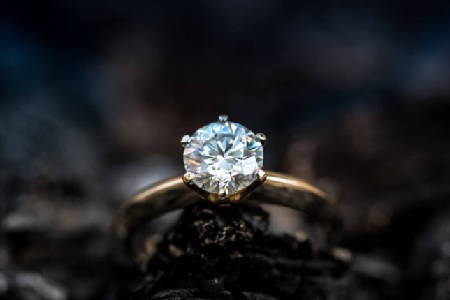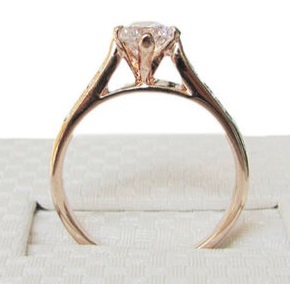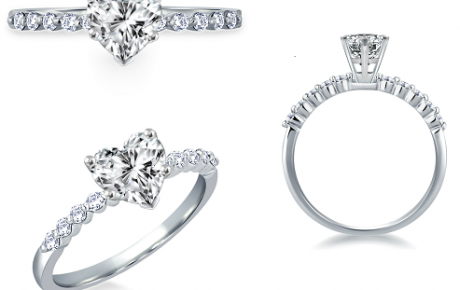How the Clarity Grade Impacts a Diamond’s Price
Diamonds are graded according to four basic qualities: carat, cut, clarity and color. Collectively, these characteristics are famously known as the “four C’s” of diamonds.
While each of these attributes plays a role in determining the price of a diamond, they do not necessarily have the same level of impact on the diamond’s appearance.
First, Let’s Take a Look at the 4Cs & Their Price-Altering Factors

Cut is arguably the most important attribute that impacts a diamond’s outward appearance and beauty. Out of the 4Cs, it is also the only factor which can be determined through human actions when a rough diamond is polished.
Undoubtedly, a diamond with better cut quality is more to be expensive as more rough material is removed and highly skilled labor is required during the polishing process.
When it comes to carat weight, this is the aspect where prices of diamonds are most significantly affected. As the weight and size of the stone increases, you can see an exponential increase in prices.
The remaining 2Cs are color and clarity which are characteristics that describe a diamond’s material properties.
In the case of color, the price jumps across different grades are actually relatively (!) small and pretty close to each other. Typically, you can expect to see a linear increase in price as color grades improve.
When it comes to clarity, prices increase linearly in the lower grades. However, the correlation between price and clarity grades can be shocking especially we look at higher ratings in the clarity scale.
For example, a jump from slightly included stones (SI) to very slightly included stones (VS) isn’t going to be colossal. But as soon as you reach the VVS or IF levels, prices start to follow a steep curve and rise in a staggering manner.
Price Chart Comparison of the Various Clarity Grades
Below is a price chart taken from JamesAllen.com based on similar 1 carat sized round diamonds with excellent cut, F color, excellent polish/symmetry. In a nutshell, clarity is the only variable here and you can clearly see how the prices change with increasing clarity levels.

Price comparison of one carat diamonds with different clarity ratings.
From the price chart above, you can see that a 1.00 carat round diamond with F color, SI2 clarity retails at approximately $6,500. On the other hand, another diamond with similar specifications (except for a VVS1 clarity) retails at approximately $13,500.
While there is only a difference of 5 clarity grades from SI2 to VVS1, it results in a whopping 100% increase in prices! Needless to say, the price jump is even higher if we were to compare internally flawless diamonds instead.
Why Do Prices Vary Even Within the Same Grade?
If you are observant, you might have noticed the small variances in prices for each clarity grade.
For example, within the VVS2 grade, the 3 diamonds listed above have the following prices: $11,620, $11,920, $12,620. These differences in prices are usually due to subtle reasons like the precision of cut (table/depth variations, optical symmetry etc…), the types of inclusions or even vendor markup.
The point I want to bring across here is that a cheaper stone doesn’t necessarily mean it is worse. Likewise, you cannot assume that a more expensive stone is necessarily better.
In order to determine which diamond has better optical performance or cut precision, you need to analyze additional data like Idealscope/ASET or Sarin reports.
Wait… Did You Leave Out the Flawless Category?
Yes, I did. The reason why I didn’t include flawless diamonds in this comparison is that I couldn’t find any within the 1.00 carat, F color, triple excellent range. Believe it or not, flawless diamonds are super rare and generally unavailable in the consumer market. In fact, you shouldn’t be surprised that most jewelers will never even see one in their entire career.
There are a couple of reasons why flawless diamonds are so scarce.
First of all, it is extremely rare to find suitable rough stones that can be polished into flawless grades. Even if cutters are willing to take the risk to polish a flawless diamond, the end product only caters to a very small and specific niche segment of consumers.
Also, running a profitable jewelry business is all about selling and moving inventory to make money. Most distributors won’t risk having a huge sum of capital locked into an inventory of flawless diamonds which they will have a hard time selling.
Instead, a more viable business strategy would be to buy several diamonds of lower grades where there is stronger consumer demand for them. So, if you do come across flawless diamonds listed for sale, don’t be surprised to see astronomical prices for them because of their rarity.
Ok, What About Included Diamonds?
Included diamonds (I1-I3) are a huge minefield to venture into even for educated consumers. I left them out as well because I don’t recommend anyone buying diamonds from the included range.
Why? That’s because 99% of the time, included diamonds either have imperfections that affect their brilliance or flaws that pose serious durability issues.
Here’s one such example you can see for yourself below and feel free to click on the link to view full details of the listing.

G Color, I1 clarity diamond that looks cloudy and has surface reaching feathers – $3,520
It’s no coincidence that these are the kind of stones that often appear in “blow-out” sales where prices are ridiculously low. After all, why do you think jewelry stores can afford to market their inventory at “80% off” sale prices?
Do you really believe that you can get a good deal in such “once-in-a-lifetime” sales?
Well, the ugly truth is that most jewelers aren’t giving discounts when they are running massive sales. They are just offering lower quality stones for sale and hoping to off-load them to unsuspecting consumers.
How Should You Spend Your Money?
When you have to purchase an engagement ring within a limited budget, you need to be realistic and strike a balance between your requirements. Clarity is often the attribute that you can make compromises on without any detrimental impact on the diamond’s appearance.
Do you really need to pay more for a diamond that has higher clarity when you can buy one with a lower clarity grade which would look exactly the same to the naked eye?
This is a question no one else can answer but yourself. With the relatively big sums of money involved in a diamond purchase, I think it is wise to give yourself more time to think over what you want before you start to shop.
With that understanding in place, we will dig deeper into selecting slightly included diamonds and highlight the things to take note of on the next page…
Related Articles
Leave A Comment














10 Comments
Hi Paul! Thanks for such an informative website!! The diamond quality chart and price provided is really helpful. I know you recommend buying diamond rings online but what do you think of Jared? Can you recommend me a physical store around DC area to look for a diamond ring? Thanks again!
Thanks for the kind words. You can actually find more information about Jared here: https://beyond4cs.com/reviews/jared-jewelers/
Personally, I’m not a fan. For physical stores around the DC region, I don’t know of any physical stores well enough for me to make a recommendation. The thing is, you don’t get better quality, better protection and better prices in physical retail. You only get them with the online vendors which makes your shopping risk-free.
My name is Lawrence and I’ve been reading your website for a month now trying to learn as much as I can about diamonds before buying. Thanks so much for all the hard work and time you’ve put into it for us laymen.
I’m in the hunt for a 2-3carat cushion cut with a 45k budget. I came across this one on James Allen:
https://www.jamesallen.com/loose-diamonds/cushion-cut/2.52-carat-d-color-vs2-clarity-sku-1032705
I have a few questions I hope that you may be able to answer:
1. It seems pretty good but I’m really not sure how well the 360 viewer captures the inclusions. The picture on the GIA report shows that there’s quite few on the bottom portion of it.
2. Another thing I’m a little worried about is the girdle. Does the thick girdle make a big difference in its shine?
3. Given the color, polish, and symmetry, I don’t think that the fluorescence will make the diamond hazy will it? Like you, I also think fluorescence is a pretty cool effect.
4. I believe this is a broad flash as opposed to a pin fire?
5. Lastly, do you ultimately like this diamond for the price?
6. My last question is about pricing. Do you think I should wait a little longer as prices may be inflated from the holidays and Valentine’s Day? I plan for a proposal in May.
Paul, thanks so much for taking the time. I sincerely appreciate all your help!!
The inclusions are accurately plotted and can actually be seen in the video. Just because the clarity plot shows a concentrated or alot of marked inclusions, it doesn’t mean that it would be readily seen at 10X.
As for the girdle, the thick girdle is inconsequential. For cushion cuts, a thin to very thick girdle is OK and this depends on a case by case basis which needs to be evaluated individually. Cut quality and light return will take precedence over the importance of girdle thickness.
Faint fluorescence is not an issue. A faint intensity level is far too low for you to see the cool effect of a nice blue glow in black lights. To get that kind of effect where it is immediately obvious, you need to go up to medium or strong.
That said, the inclusions are eyeclean and this diamond has a broad flash patterning to its facet structure.
Diamond prices have already been hiked due to an increase in the upstream processes (ie, rough diamonds) prior to Valentine’s Day. And it is not coming down anytime soon as prices were at all times low for a couple of years and have steadily been increasing. Contrary to what you think, diamond prices don’t fluctuate during peak seasons.
Now, when it comes to large size diamonds, ED, Blue Nile and James Allen are vendors I would start my search at with well cut diamonds (especially cushion cuts). These are 3 stones that I would recommend instead.
SKU C250-16Z65935Z
SKU C270-5607493Z7
SKU C250-831836872
I have an extremely strong preference for the first diamond as it offers superb value for money and is MUCH better cut than the JA diamond. That’s the diamond I would personally buy.
If you need a D diamond, the 3rd diamond is again, a hands down winner compared to the stone you picked at JA. It has stronger light return and is significantly less expensive given the big jumps in clarity.
You are the man! What a thoroughly detailed email. Thank you so so much!! I had no idea about the inflation so I guess I’ll be buying a diamond soon.
The links you provided look amazing. The third diamond looks so clean! Yet, the first diamond seems like such a steal at nearly $10k cheaper.
Between a D and an E, there really can’t be much of a difference to the naked eye can there? I plan on going into a store on Wednesday to see if I can put a D and an E side by side and see in real time the difference.
I also noticed the inclusions around the left side of the table on the first diamond. I’m assuming these should be eye clean as well? I remember bringing my girlfriend to a diamond store and she would stare at a diamond pretty much at eye lash level looking for inclusions. I know she’s the type where if she were to see an inclusion, she’d never unsee it.
I’ll have a hard time deciding between the two. Thanks again, Paul
Let me tell you the decision is really easy. If I were to buy a diamond, this is the diamond I personally would get: SKU C250-16Z65935Z
It’s going to face up whiter than the JA stone. It’s at a great price point and is eyeclean.
https://beyond4cs.com/clarity/resize-technique/
Also, you shouldn’t be too hung up on color. Here’s a video comparison of different diamond colors in a side by side comparison. The differences in real life are more subtle than what most people think.
https://www.youtube.com/watch?v=SP_TP2nY2XM
This is my very last question for you. I went to maybe 4 jewelers today. I showed one of them the specs of the stone that you liked. He was not impressed with the inclusion saying that the crystal inclusion on the table can be seen. He also said that a diamond with an inclusion on the table is a very bad idea for resale purposes. He’s a salesman so I am wary with his statement. Another lady at another store said that crystals are bubbles which may appear black. Since the one I’m looking at is a VS1, she said the inclusions may or may not be able to be seen depending on the angle at which you look at it.
One jeweler steered me into a diamond with the following specs:
https://www.gia.edu/report-check?reportno=1182160031
Going price is around $33k
Is this one better you think than the one we’ve been looking at for the price? The color is a grade down, but the clarity is up. I can tell the color differences of a D, E, and F side by side but of course, I won’t be comparing diamonds side by side all the time in real life.
I may just end up paying for the one just so that I can see it real life.
Sorry for all the questions!!!
Let me tell you with strong affirmation that SKU C250-16Z65935Z a fantastic and 100% eyeclean diamond.
What kind of nonsense are these sales people sprouting? Go look at ALL their diamonds and see if will not find a single stone with inclusions under the table. Ask them why they are contradicting themselves when you find one. And just for argument sake, the VVS 2 has inclusions under the table.
All diamonds have bad resale value to begin with. Buy any diamond in store and IMMEDIATELY after 5 mins of walking out of the store, head back into the store to sell the exact diamond back to the person who thinks that diamonds have resale value. If you can do it and receive cash for more than 70% of what you paid, I would be amazed.
https://beyond4cs.com/investing-in-diamonds/
Anyway, it’s pretty normal for salespeople to have zero interest in the consumer’s needs and have terrible gemological knowledge.
Crystals are NOT bubbles. They are embedded minerals.
And just for your info, the grade making inclusion for this stone is the feather and not the crystal. Inclusions are listed in the order of severity in all gia reports. And again, it goes to show how little knowledge sales people have. You would be doing yourself a massive disservice without questioning what was said.
Really, if you read up on Beyond4cs.com, I guarantee you will have better knowledge than 99% of salespeople who are peddling goods in stores.
And you are putting emphasis on the wrong thing. Clarity is not the issue here. Cut quality is. A diamond with IF clarity with poor cut quality will not look as good as an SI or VS diamond with better cut quality.
I’m looking at AGS104112974041, AGS104111473058 and AGS104113112016 all from Whiteflash I’m so confused as to which would be the best purchase. Is there a big difference between all 3 as to size? Would they appear very small in a simple yellow gold solitaire setting? I’m replacing a ring that was stolen several years ago and just want good quality with a beautiful appearance.
In terms of visual appearance, the diamonds will look similar in body color and clarity to the unaided eye. These diamonds are all eyeclean and the only difference you most likely would see is in size. There will be obvious size differences between the 0.834ct diamond when compared with a 0.734ct diamond. Given that a VVS2 clarity grade in the 0.734ct is excessive, I would actually gravitate towards the other diamonds to get better value for money.
Personally speaking, this is the diamond I would buy: https://www.whiteflash.com/loose-diamonds/round-cut-loose-diamond-4367834.htm
It is exceptionally well cut for light return and the clarity grade of VS2 lies in a sweet spot to get a clean looking diamond without having to pay the premium for a VVS2 clarity rating. Go for the diamond above. It’s a great option and good job picking it out!